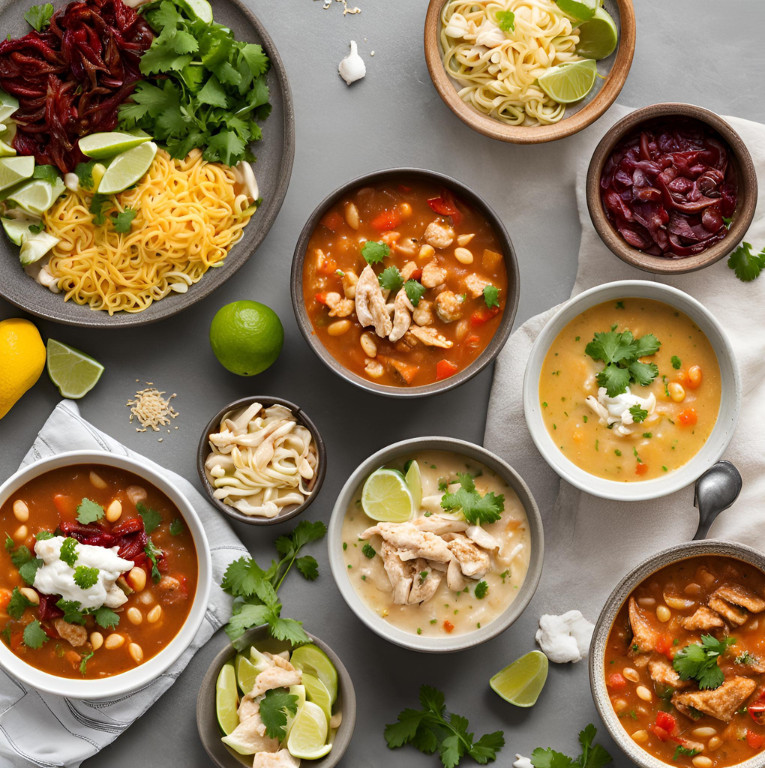introduction
I read somewhere once that every culture has a food that qualifies as a “dumpling,” from wontons in China to madombi in Botswana. But if there is another dish as universally beloved, it might just be chicken soup: a comforting tradition that transcends borders, cultures, and seasons.
It’s generally accepted that chickens were first domesticated between 8000 and 5000 BCE in southeast Asia, and in due course, this practice spread across the world. Chickens are incredibly versatile, efficient, and adaptable animals, providing a reliable and cost-effective protein source that can be raised in small backyard flocks as easily as on large commercial farms.

They thrive in a wide range of climates, are inexpensive to feed, and have a rapid growth cycle. Moreover, they can be consumed at every stage of life, from eggs to full-grown adults, thus making them a readily available nutritional resource for people across all socio-economic backgrounds.
Sometime around the second century BCE in China, we find the first evidence of chicken being prepared in soup form, where it was associated with “yang” energy and given as a restorative tonic to the weak or infirm, the elderly, and pregnant women.
By ancient Greek times, chicken soup was being consumed on the advice of the philosopher Galen. Centuries later, in the late 12th century, it was prescribed by the Jewish physician and polymath Maimonides (more on him later).

Today chicken soup remains a global symbol of comfort and healing, immortalized in culinary traditions “for the soul” worldwide and a delicious, nutritious, budget-friendly choice for cooks everywhere.
chicken soup variations across the globe
Let’s look at some variations of chicken soup from around the world and uncover the secrets behind its enduring, universal appeal—from its rich history and cultural significance to its comforting flavors and undeniable health benefits.
china

Go looking for the origins of just about anything tied to human civilization, and sooner or later, you’ll find yourself in China. The oldest continuous civilization on Earth has been practicing medicinal cooking since the Shang Dynasty (1766–1154 BCE), using food and herbs to treat and prevent disease.

By the Tang Dynasty, detailed works on nutrition and food therapy had emerged, including the Huangdi Neijing (The Yellow Emperor’s Canon of Internal Medicine, circa 780–403 BCE). This foundational text not only explored food’s role in overall health but may also be the first documented instance of chicken soup prescribed as medicine.

In traditional Chinese medicine, maintaining balance and harmony in the body is central to well-being, and this philosophy elevated the status of “food doctors”—specialists tasked with keeping royal families healthy—above even the physicians and surgeons of the time. Their job wasn’t just to heal but to create dishes that were as nutritious as they were beautiful and delicious.
Chicken soup earned its place on the royal table because of its association with yang energy, thought to restore warmth and vitality to those suffering from an energy deficit. Noodles were often added, adding substance, representing a wish for a long and healthy life, and transforming the dish into the earliest version of chicken noodle soup.

The pairing of tender chicken in a rich, restorative broth with long, nourishing noodles didn’t stay confined to royal tables for long. Noodle shops quickly adopted the dish, serving it to the masses, where it became a beloved staple—centuries before Campbell’s Soup Company ever thought to combine the two.
Today in China, chicken and noodle soup — often flavored simply with ginger, green onions, and a splash of sake — is a staple at birthday celebrations, and is prepared by mothers and grandmothers as an expression of care and healing. The noodles symbolize longevity, while eggs are sometimes added for an extra boost of protein and good fortune.

China’s vast size and rich diversity give rise to countless regional variations of chicken soup. Cantonese-style soups are delicate and clear, often infused with medicinal herbs, while Sichuan-style versions turn up the heat with chilies and Sichuan peppercorns. In the North, the soups tend to be heartier, enriched by the addition of root vegetables and thick, wheat-based noodles.
There’s an old Chinese saying: “Eating soup is like drinking wisdom.” With its nourishing warmth and restorative simplicity, it’s easy to see why. Want to clear your head and lift your spirits? Try this simple, comforting recipe inspired by Chinese tradition and discover for yourself if the wisdom holds true!
senegal

Maafe Ginaar, a savory chicken and peanut stew, is a treasured dish in West African cuisine, particularly in Senegal and Mali. Its origins trace back to Mali, where it was developed by the Mandinka and Bambara people. Over time, it spread to neighboring regions, including Senegal, carried along trade routes and cultural exchanges, eventually becoming a staple in Senegalese cooking.
Senegal’s culinary heritage is a rich tapestry woven from its history and geography. Once a French colony until gaining independence in 1960, Senegal’s cuisine reflects a blend of French and North African influences alongside indigenous West African traditions. French culinary techniques and ingredients, such as the use of stocks and reductions, meld with North African spices and cooking styles, creating a unique fusion.

Peanut farming, introduced to West Africa in the 16th century, became vital to Senegalese agriculture and cuisine. Today, peanuts remain the country’s primary cash crop and a cornerstone of its food culture.

Maafe Ginaar showcases this culinary diversity with its many regional and personal variations. Some versions include okra, cabbage, or sweet potatoes for additional texture and flavor, while others incorporate spicy chili peppers for heat. Despite these differences, all versions of Maafe share a rich peanut base, achieved with peanut butter or freshly ground peanuts, which lends a creamy consistency and nutty depth to the dish.
Traditionally served over white rice or couscous, Maafe Ginaar is a communal dish, often enjoyed during family gatherings or special occasions. It reflects the importance of shared meals in Senegalese culture, where food is as much about connection as sustenance. Making this dish in your kitchen offers a delicious way to explore the flavors and history of West Africa, where every bite tells a story of tradition, innovation, and resilience.
turkey
Now we travel to Turkey, where we find terbiyeli tavuk çorbası, or egg-lemon chicken soup. A cherished dish in Turkish cuisine, this soup is particularly popular during the winter months, when a bowl of hearty, steaming soup ladled over some crusty bread chases away the cold and brings warmth and wellness to those who partake.
The terbiyeli in the name refers to the addition of a thickening mixture made from egg yolks, flour, yogurt, and lemon juice. In a literal sense, the word terbiye conveys the idea of “refining” or “improving,” and it’s easy to see how tempering this mixture into the soup transforms a simple broth into something richer and more substantial, yet still brightened by the freshness of lemon and herbs.
In Turkey, soup isn’t just a first course; it’s a deeply ingrained part of daily life. Whether served at breakfast with a sprinkle of chili-infused butter or enjoyed as a restorative meal after a long day, soups like terbiyeli tavuk çorbası are loved across the country. Variations of this dish often reflect the ingredients and culinary traditions of different regions. For example, in some areas, locals may add rice or vermicelli to give the soup additional texture, while others might incorporate root vegetables or dried legumes for a heartier meal. The choice of herbs also varies, with parsley, dill, or even mint lending their unique aromas to the dish.
Historically, this style of soup may have evolved from Ottoman palace kitchens, where egg-lemon tempering techniques were refined and adapted to a wide array of dishes. The tradition of thickening and flavoring soups with a terbiye mixture spread throughout the region, influencing many neighboring cuisines. Even today, its roots can be seen in Greek avgolemono soup, another dish that pairs chicken and lemon to delightful effect.
In modern Turkey, terbiyeli tavuk çorbası is often considered a comfort food and a remedy for those under the weather. With its nourishing chicken broth, protein-packed egg yolks, and vitamin-rich lemon juice, it’s the perfect antidote for a cold winter’s day—or a cold, full stop. The dish is easy to make yet elegant in presentation, striking the perfect balance between humble tradition and culinary sophistication.


Leave a Reply